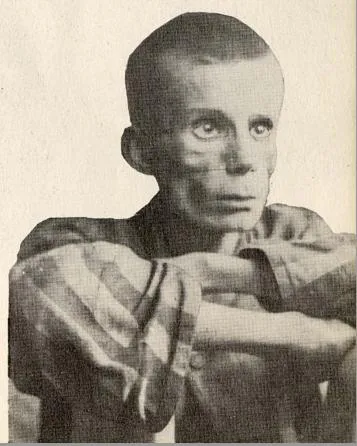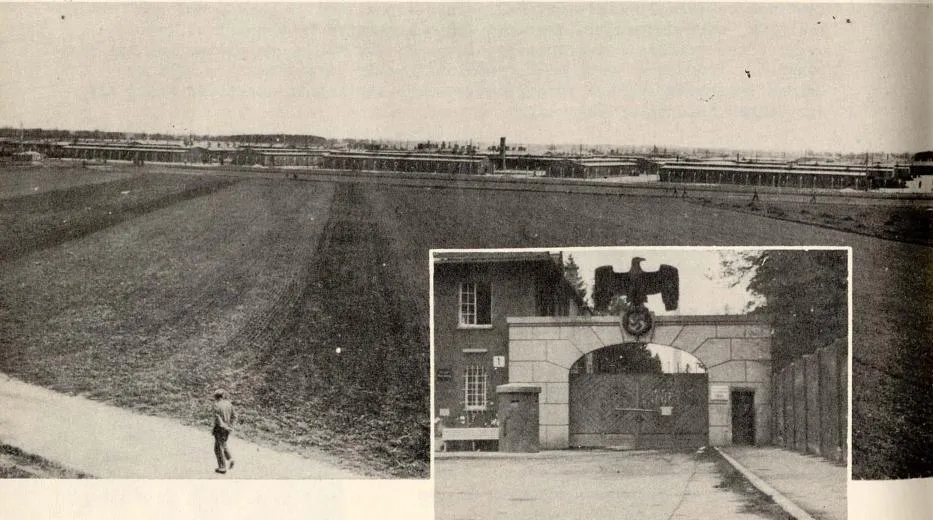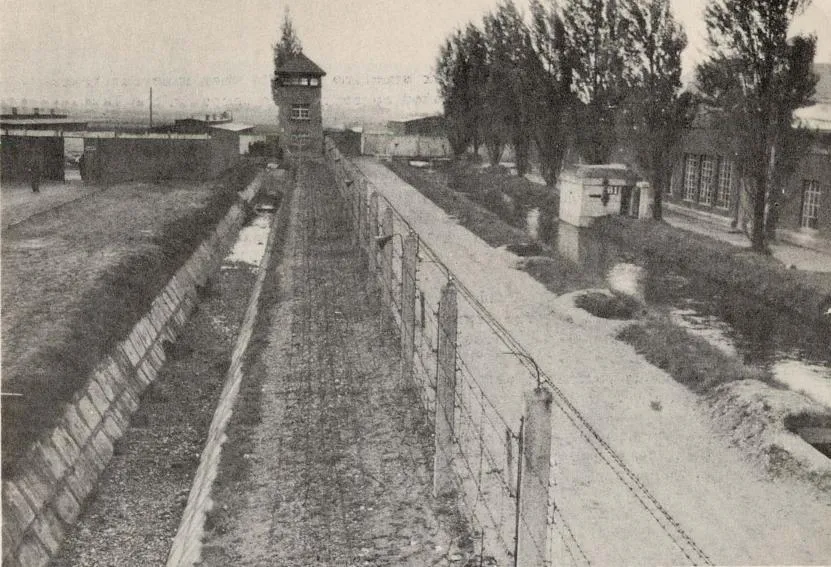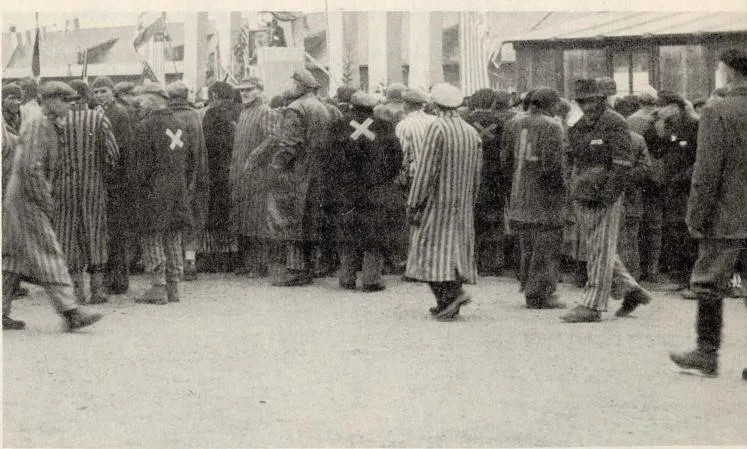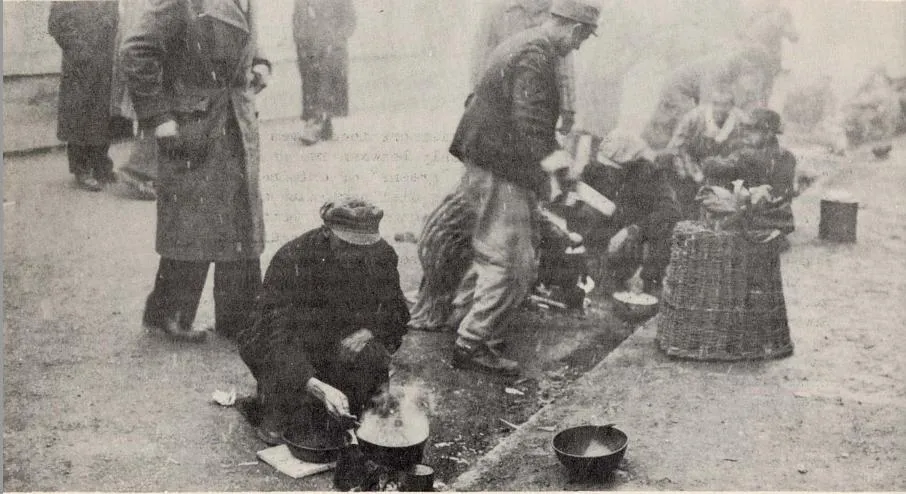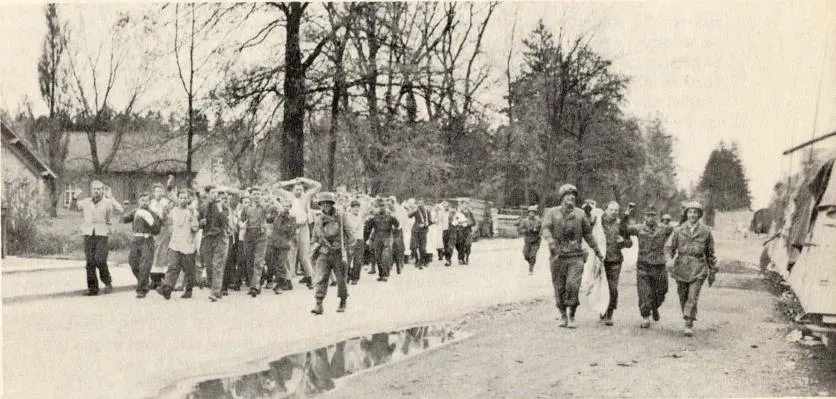![]()
DACHAU CONCENTRATION CAMP—OSS Section, Seventh Army
SUMMARY
At Dachau the only objective of the inmates was to survive under the most primitive and cruel conditions which constantly threatened their sanity and physical existence. Little more than this was humanly possible. As a result of these abnormal conditions, this camp of 30,000 men cannot be compared to the structure of any normal society differentiated by social classes, political, religious, or professional affiliations. Hence, neither normal moral standards nor normal political or sociological criteria are applicable to the Dachau situation.
The inmates of the camp did not act as members of their former social class or as representatives of political or religious groups—whether they were professional men, workers, intellectuals, Communists, nationalists, Catholics, or Protestants—, but only as human beings in a struggle for survival against starvation and mass murders. This was true as much of the minority of those who took charge of the internal organization of the camp under the SS as of the majority of those who did not.
Living under these abnormal conditions, the inmates, especially those who had gained a position of some power and security, were frequently degraded and degenerated to a criminal level copying the methods and practices of the SS for their own protection and benefit. Because so many of the administrative positions were held by German prisoners, rather strong anti-German sentiments developed among the non-German inmates of the camp.
The only form of self-organization among the prisoners took place within the framework of the internal organization of the camp. The “Labor Allocation Office” (Arbeitseinsatz) and its subsidiary branches was the key agency which was successively in the hands of different cliques who frequently abused their position of power for the sake of personal advantages. These groups were composed largely of Germans until the last six months.
Otherwise, the level of existence in the camp together with the insidious system of internal controls, whereby prisoners themselves were placed in the service of the SS, did not permit the emergence of any organizational form. There was no underground organization or political activity in the accepted sense of the word. Even expressions of mutual help and solidarity among members of the same national group never transcended the level of personal relations between people bound by friendships, common background, and language. They never took the form of organized action.
Only during the last phase of the camp, an organizational network was set up between leading representatives of various nationalities which led to the formation of the “international Prisoners Committee”—today the highest authority in the camp. This Committee was concerned entirely with matters of self-help in preparation of the eventual liberation of the camp. It has never been dominated by any political program or orientation.
This report is based on two days’ investigation of conditions in the Dachau Concentration Camp. It does not intend to give either an exhaustive history of the camp or a comprehensive survey of all aspects of camp life. Numerous reports are in the process of being written which, when completed, will give a full picture of the Dachau Concentration Camp. This report is concerned primarily with one aspect of life in Dachau: the internal organization of the camp, the evidence of self-administration among the prisoners and the emergence of special control and pressure groups, as well as the position of the various social, political, and national groups within this organizational framework.
![]()
HISTORY
Dachau is the oldest Nazi concentration camp. It was set up in March 1933 and constructed to house a maximum of between 8,000-10,000 prisoners. It was designed to serve as a camp for German political prisoners and Jews. Early 1935, however, the first criminal prisoners arrived in the camp and, ever since then, the camp has included a small minority of criminal prisoners. The original number of inmates grew substantially in 1937 after the German annexation of Austria and Czechoslovakia. During the war the prisoner body was further increased steadily through the influx of political and military prisoners from the occupied territories and through numerous transports arriving from other German concentration camps. The first Polish prisoners arrived in 1940, to be followed in 1941 by prisoners from the Balkan countries, and in 1942 by the first Russian prisoners. Throughout this period the camp also absorbed a large number of prisoners from the occupied Western countries, especially France.
While the total number of inmates fluctuated—owing to incoming and outgoing transports and the systematic policy of extermination in the camp—it was generally, during the war, between 22,000 to 30,000; roughly three times the maximum capacity of the camp. It reached its peak sometime in 1944 when numerous transports arrived from the evacuated concentration camps in the East (e.g. Auschwitz), the West (e.g. Natzweiler) and inside Germany. Dachau then held more than 60,000 prisoners and included an entire network of smaller subsidiary camps located in its immediate surroundings, These over-crowded conditions were largely responsible for the subsequent increase in the death rate at the camp. Aside from the official murders by the SS, thousands and thousands of prisoners died during the fall and winter of 1944 from starvation and typhus.
Shortly before the camp was liberated, the Nazis sent out a large transport of special prisoners, consisting chiefly of Russians, Poles, Germans, and Jews. The Nazis also evacuated the so-called “honorary prisoners” (Ehrenhäftlinge), i.e. the famous political and religious hostages they held at Dachau (Niemoeller, Schuschnigg, Daladier, Blum, etc.). Plans to destroy the entire camp were apparently foiled at the last moment. At the time of liberation there were about 32,000 prisoners left in Dachau. The daily rate of people dying of exhaustion, starvation, and typhus was about 200. It is now between 50 to 80.
COMPOSITION
The inmates of Dachau can be classified according to two categories:
(a) by nationality, and
(b) by the type of crime of which they were accused.
The differentiation by nationalities of course, only arose during the war when the camp began to include different national groups. Before the war the number of foreigners was insignificant. German, Austrian, and Jewish prisoners represented the numerically strongest groups.
During the war, the Germans and Austrians became a numerical minority. The numerically strongest national group were the Poles, followed by the Russians, French, Yugoslavs, Germans, Jews, and Czechs, A rough estimate at 1 May 1945 gives the following statistical break-down: Poles: 9,200; Russians: 3,900; French: 3,700; Yugoslavs: 3,200; Jews: 2,100; Czechoslovaks: 1,500; Germans: 1,000; and a number of other national groups (Belgians, Hungarians, Italians, Austrians, Greeks, etc.) below 1,000, The average number of Germans held here during the war, however, was about 3,000, Some two thousand Germans were evacuated and killed in the last big transport a few days before our occupation of Dachau.
Although it was the practice of the camp management to keep the various national groups mixed up with each other, members of the different nationalities always retained a natural sense of belongingness, solidarity and group-feeling.
The prisoners were further divided according to the type of crime of which they were found guilty indicated by differently coloured patches worn on their uniforms or work-clothes. The most important patches were the red ones identifying political prisoners, the green identifying criminal prisoners, and the black identifying “asocial” elements, i.e. people who had violated labor regulations, committed sabotage, etc. There were numerous other patches (pink, purple, yellow) identifying other crimes. Prisoners of war sent to Dachau were treated and designated as political prisoners.
As far as the prisoners themselves are concerned, the camp was divided sharply only between two groups: the “reds” or political prisoners and the “greens” or criminal prisoners. The SS tried to break down this distinction by an ingenious system of creating a “prisoners’ elite”, composed of both “reds” and “greens”, which assumed power over the internal organization of Dachau, controlled and frequently terrorized the camp in the name of the SS, but formally independent of the SS. This system of internal organization will be discussed in the following section. However, despite this organization of internal corruption and terror, by which the SS exercised its control indirectly, the mass of political prisoners continued to live in sharp separation from and opposition to the “criminals” and most of the prisoner bosses whom they despised, feared and hated.
It is impossible to classify prisoners according to any other category—either by social status, class, background, or by previous political and religious affiliations. These factors dividing people in a normal type of society are totally inapplicable to the situation at Dachau where people lived the most abnormal kind of existence imaginable. Regardless of origin, education, wealth, politics, or religion, people living in Dachau for a certain time were gradually reduced to the most primitive and cruel form of existence—motivated almost exclusively by fear of death. They no longer acted as former bankers, workers, priests. Communists, intellectuals or artists, but primarily as individuals trying to survive in the physical conditions of Dachau, i.e. trying to escape the constantly threatening death by starvation, freezing, or execution. Some may still have thought of themselves in terms of their former social and political background or labels; but it is important to ask to what extent these old social labels determined their actions during the time of their imprisonment at Dachau. As far as we could ascertain, these factors are completely irrelevant for explaining the behavior of the inmates of Dachau. Living conditions in the camp were such that all former professional, social and political distinctions were gradually obliterated. People still behaved differently, some well and courageously, others evil and cruelly; but these differences cannot be derived from or identified with their former social labels (whether aristocratic, military, intellectual, or proletarian), but simply reflect the different personal reactions of individuals to a situation in which all are reduced to the most primitive social level of a struggle for mere physical survival.
ORGANIZATION
The organization of the camp was based on the system of indirect rule. There were two separate spheres of controls:
(a) the external control apparatus of the SS Guards; and
(b) the internal control organization in the hands of the prisoners themselves.
The organization of the SS Guards is comparatively unimportant. It followed the regular pattern of this paramilitary outfit. The key positions seem to have been the “camp commandant”, in charge of the entire SS establishment Dachau, next, the SS leader, in charge of the labor gangs and transports (Arbeitseinsatzführer); and finally the position of the intelligence officer (Vernehmungsführer) of the Political Division, in charge of security, discipline, and punishment.
These men, however, and their subordinates exercised hardly any direct control whatsoever. Instead, they used as instruments for their rule the internal organization of the camp in the hands of the prisoners themselves. This internal organization of the prisoners followed the regular pattern of a Nazi hierarchical regime. It was headed by a camp senior (Lagerältester); under the camp senior there were (a) the secretary (Lagerschreiber) and his staff, in charge of the records, (b) the chief of police (Polizeiführer) and the camp police (Lagerpolizei), and the Chief of the Labor Allocation Office (Arbeitseinsatz) and his staff, in charge of all aspects of work performed inside and outside the camp. The Labor Office sent out the “work details” (Arbeitskommandos), of which there were about 160, each headed by a foreman called the “Capo”. Together with the camp senior these agencies and their chiefs formed the central authority of the camp.
The camp was further divided into “blocks” (Blocks) and “cells” (Stuben). And each block and each cell, in turn, had its “senior” and “secretary”, called Blockältester (Stubenältester) and Blockschreiber (Stubenschreiber) respectively.
This system of internal controls served the interests of the SS mos...

